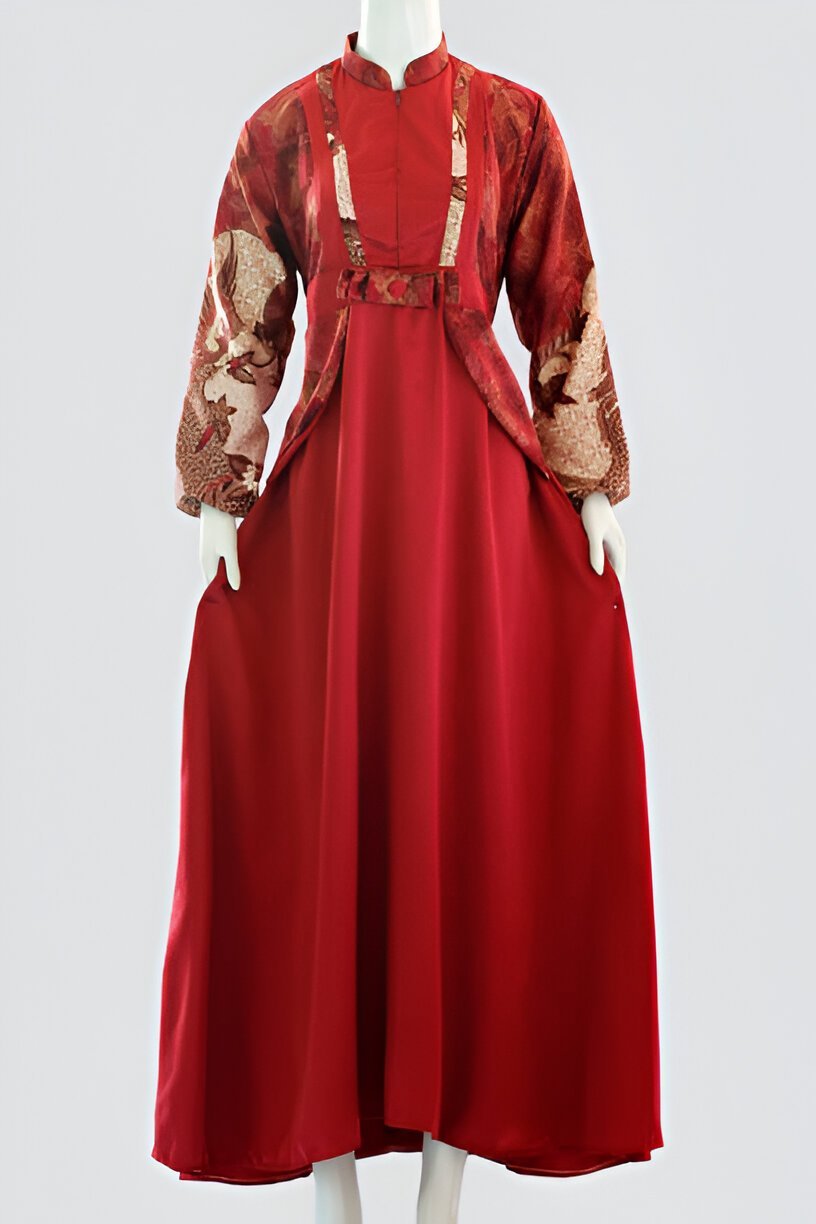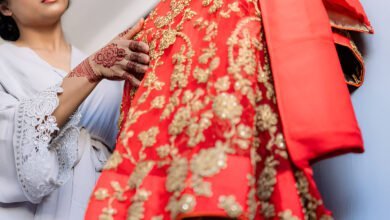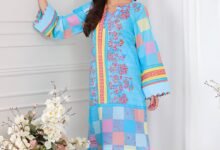Why Gown Attached Dupattas Are the Latest Fashion Trend

The Evolution of the Dress with Attached Scarf: A Marrying of Tradition and Modernity
Fashion has always been a world that changes constantly, merging tradition and modernity seamlessly in order to create new trends. One such trend is the gown with attached dupatta, which has gained popularity over the past years.

This innovative design combines the grace of traditional Indian clothes with the comfort and utility of a gown, making it an unusual piece that is both aesthetically pleasing and pragmatic. The article will venture into the roots, development, styling suggestions and cultural significance of a dress with an attached dupatta.
Top Golden Bridal Dupatta Styles for Your Big Day
Origins and Evolution
Gown with an attached dupatta is quite recent in terms of fashion. It started when people wanted something comfortable yet still maintained its traditional look. For many Indian dresses like salwar kameez, lehenga choli, or sarees; traditionally Indian women wear dupattas which are long scarfs or shawls. However carrying around a dupatta can be tiresome sometimes especially if one isn’t used to Indian clothes.

By attaching it to a gown, there was simplification in wearing while keeping its elegance and appeal as far as traditional Indian wear is concerned. As Indian fashion becomes more globalized, this kind of technological change occurs due to globalization’s influence on India’s fashion industry and the rising demand for fusion clothing appealable among both Westerners and Indians.
A gown is generally considered as western attire signified by its one-piece nature accompanied by free-flowing silhouette. A dress like this appended with a scarf can be worn for various events ranging from wedding ceremonies or festivals up to official gatherings.
Designing & Styling
There are many designs and fabrics available for a gown having an attached scarf making it suitable for different occasions as well as personal preferences Here are some popular design elements and styling tips for this elegant attire:
Material Choices:
- Silk & Satin: These rich materials are excellent for formal events. They offer an opulent feel and drape beautifully.
- Georgette & Chiffon: These lightweight, soft fabrics are perfect for a more casual look. They are great for summer weddings or outdoor functions.
Velvet: This heavy, luxurious fabric is ideal for winter weddings and night-time occasions. It brings royalty to the gown.
- Net & Lace: Such materials are usually used to make delicate patterns creating a romantic and ethereal effect in the dress.

Embroidery and Embellishments:
- Zari & Zardozi: These traditional Indian embroidery techniques consist of intricate gold and silver thread work which makes the gown look royal.
- Sequins & Beads: Make your gown sparkle with these embellishments, perfect for evening wear.
- Mirror Work: With this style, you will have a unique touch on your gown from Rajasthani as well as Gujarati design principles
Necklines and Sleeves:
- Boat Neck or Off-Shoulder – These necklines give a modern appearance to the gown
- Sweetheart or Halter Neck – These necklines make one to appear slimmer apart from elegance
- Full Sleeves or Bell Sleeves – Sleeves with fullness that adds drama and sophistication
- Cap Sleeves or Sleeveless – A contemporary more relaxed feel can be achieved by using these variations.
Dupatta Styles that are Extremely Dynamic and Perplexing
- Attached to the Shoulder: This style follows a traditional saree drape, thereby giving the gown an element of old-fashioned glamour.
- Attached to the Waist: As such, this type produces a smooth and relaxed look which is suitable for contemporary tastes when appearing chic.
- Cape Style : The dress takes the form of a cape with this kind of dupatta style which adds some glamor to it.

Cultural Significance
A fusion of centuries-old tradition with modernity in its aesthetics is what makes Indian fashion love this outfit so much. With respect to India’s ongoing fashion evolution while retaining many aspects of its rich cultural background, this dress symbolizes it well.
Weddings:
The wedding attire donned by the bride has special significance in an Indian wedding. Since it is included with a dupatta, a gown offers a break from traditional bridal wear allowing brides to feel elegant and sophisticated as well as comfortable and relaxed. The attached dupatta frees up the bride not having to worry about frequent adjustment.
Festivals:
Indian festivals are famous for their lively festivities and extravagant clothing. The dress can be worn on these occasions because they blend traditionalism with contemporaneity fit for celebratory moods. Women wearing these outfits can engage themselves into various kinds of activities or rituals without any problem at all.
Formal Events:
The gown with an attached dupatta can also be some unique option for formal events and parties. This combination still looks genuine enough for receptions, cocktail parties or other formalities marking it out from others among scores of similar attires.
Cultural Shows and Performances:
Costumes play an important role in enhancing visual appeal as well as storytelling during cultural shows/performances. Classical dance performances or even modern drama plays are examples where you may need such gowns along with attached dupattas.
The Modern Appeal
This outfit has become extremely popular with fashion-forward people who appreciate the mix of old and new. This costume finds favor with a wide range of people from young trendy females to mature elegant ladies.
Celebrities and Influencers:
Such celebrities and social media influencers have been at the forefront in embracing gowns that come attached with dupattas, thus exhibiting how versatile and appealing this outfit can be. By doing this, they have greatly helped popularize this trend thereby inspiring other fashion lovers to try on such designs.

Bridal Fashion:
Bridal designers have included dresses having attached dupatta into their couture lines, bringing in a fresh breath of air for brides who want something contemporary instead of regular sari or lehenga. Hence, this ensemble helps them to stand out while still upholding their rich cultural heritage.
Fashion Shows and Runways:
The gown with an attached dupatta has been showcased by designers during cat walks and shows identifying it as a very flexible elegant dress choice. The collections have attracted critics in the industry as well as average shoppers because of their creative styling strategies plus fashionable ideas.
Retail and E-commerce:
The popularity of the gown with an attached dupatta has resulted in its availability across retail stores and e-commerce platforms. There are various brands that avail these products catering for different customers’ preferences at different prices.
Tips on How to Style a Gown with an Attached Dupatta
Styling a gown with an attached dupatta can be a fun and creative process. Here are some tips to help you make the most of this elegant attire:
Accessorize Deliberately:
When choosing accessories, ensure that they match your dress well but do not overpower it. To create the overall look, consider using statement pieces such as chandelier earrings, pendant necklaces or maang tikka.
Choose clutch or potli bags which are matching the color and embellishments on your gown.

Footwear:
The footwear should provide comfort while giving you style. Heels or sandals that come with additional decorations will add elegance to your outfit.
Ensure that such shoes go along well with the general color scheme and design of the gown.
Hair and Makeup:
If one is going for traditional look then she can try using hair styles like elegant updo or braided one adorned with flowers or hair accessory.
Casual waves or sleek ponytails can also look stunning when combined with this type of gown.
Makeup that highlights your features as well as matches the dress color is worth considering. A simple smoky eye shadow or bold lip may add glamour to your appearance.
Layering:
During different weather occasions, layers like jacket or shawl can be added. Adding a velvet/silk shawl during winter wedding creates warmth and dignity at the same time.
In addition, capes and shrugs give modernity in terms of fashion while wearing them.

Conclusion
The gown with attached dupatta exemplifies how fashion continues evolving fusing tradition and modernity resulting in inventive multifaceted designs. This apparel offers individuals an opportunity to maintain their cultural background while still looking attractive and comfortable.
This article is meant for brides in search of contemporary yet traditional dresses for weddings, individual fashion enthusiasts who need something unique in their wardrobes and people who find fusion wear convenient; it is about a gown with an attached dupatta. The gown has been on a steady rise in popularity and is projected to be around for many more years as an enduring feature of contemporary Indian fashion.
While the fashion industry continues to advance and strive for improvements, this gown with a dupatta is an example of how the old can meet the new. The dress combines chicness and utility while embracing India’s deep-rooted traditions in a contemporary way.












